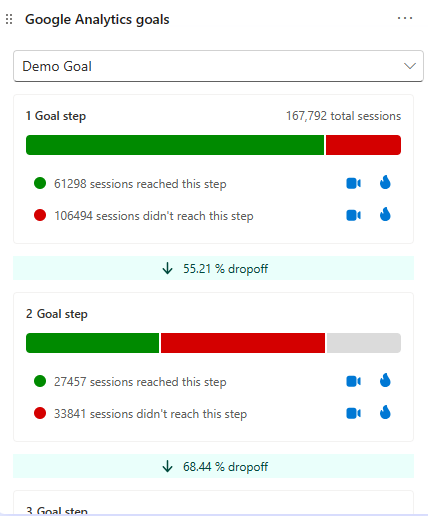What Data Is Google Analytics Goals Unable to Track and Why
What Data Is Google Analytics Goals Unable to Track and Why
Blog Article
Discover the Limitations of Google Analytics Goals: Revealing the Data Types That Remain Untrackable
As services significantly rely on data-driven decision-making, understanding the restrictions of devices like Google Analytics comes to be critical. While Google Analytics Goals deal important understandings into user interactions, there exist data kinds that thwart tracking, presenting challenges to a thorough understanding of user habits.
Incomplete Individual Journey Tracking
Insufficient user journey tracking within Google Analytics can hinder the capacity to precisely assess user actions. When the individual journey is not completely tracked, there are spaces in the information that prevent an extensive understanding of exactly how individuals engage with a website. This lack of understanding can result in missed out on possibilities for optimization and renovations to the user experience.
One typical issue with insufficient customer trip tracking is the failure to see the full course that customers take in the past finishing an objective or leaving the website. Without this info, it is challenging to determine where customers might be coming across obstacles or friction points that avoid them from converting. Additionally, incomplete monitoring can obscure the influence of specific marketing initiatives or internet site modifications on individual behavior.
To resolve this restriction, it is important to establish up appropriate tracking devices within Google Analytics to record the whole user trip. This may involve establishing event tracking, objective funnels, or using devices like Google Tag Manager to guarantee that no important communications go unrecorded. By acquiring an extensive sight of the user trip, web site owners can make more informed choices to enhance customer interaction and drive conversions.
Attribution Challenges
Browsing via attribution challenges in Google Analytics calls for a detailed understanding of how different touchpoints add to the overall conversion process. Acknowledgment difficulties arise from the intricacy of contemporary consumer journeys, where users communicate with several networks prior to converting. Google Analytics provides various attribution models like initial touch, last touch, and linear, each providing a various point of view on just how credit report is assigned to touchpoints along the conversion path. Nonetheless, these models may not constantly accurately show real effect of each touchpoint on the conversion.
One typical attribution obstacle is the difficulty in attributing conversions to the appropriate source, specifically in instances where customers engage with multiple channels before converting. This can result in inaccuracies in identifying which marketing efforts are driving the most conversions. Additionally, cross-device monitoring positions one more acknowledgment obstacle, as users usually switch between devices throughout their journey, making it testing to track their interactions seamlessly. Online marketers have to very carefully assess and analyze attribution information to make enlightened choices and enhance their advertising techniques successfully.
Offline Conversions
Provided the obstacles connected with associating conversions accurately in online networks, the measurement of offline conversions presents a considerable opportunity for marketers seeking a more thorough understanding of their customers' journey. Offline conversions describe actions that clients absorb the physical globe, such as making acquisitions in brick-and-mortar shops or over the phone, going to events, or involving with published products - what data is google analytics goals unable to track. These conversions are important for businesses that operate both online and offline, as they give valuable insights right into the performance of marketing campaigns throughout numerous touchpoints
Tracking offline conversions generally postured a substantial difficulty for marketers, as it was challenging to link these activities back to details online interactions precisely. With improvements in modern technology, such as the assimilation of CRM systems, unique identifiers, and voucher codes, organizations can currently connect the space between online and offline data to gain a much more alternative view of customer actions. By properly measuring offline conversions, marketing experts can enhance their techniques, allocate sources extra effectively, and eventually enhance the overall client experience.
Cross-Device Tracking
Cross-device monitoring plays a vital duty in understanding the interconnected nature of consumers' electronic interactions across multiple devices. In today's omnichannel globe, where individuals effortlessly switch over between desktops, tablet computers, and smartphones, tracking their behavior throughout these that site tools is necessary for marketing experts to get an extensive sight of their customer journey.

Furthermore, privacy problems and policies such as GDPR and CCPA have additionally difficult cross-device monitoring. With users requiring even more control over their information and enhanced constraints on monitoring modern technologies, online marketers need to find privacy-compliant and innovative ways to connect customer communications throughout devices.
Dynamic Web Content Engagement
Recognizing user interaction with dynamic content is essential in maximizing digital advertising techniques for improved audience interaction. Dynamic content refers to website components that change based on customer habits, preferences, or other factors, using a personalized experience. Nevertheless, tracking individual interactions with vibrant content poses challenges for typical analytics tools like Google Analytics.
While Google Analytics can track basic communications like clicks and page sights, it might battle to catch more nuanced engagements within vibrant material. what data is google analytics goals unable to track. Metrics such as time spent on details dynamic aspects, float actions, or communications within pop-ups are often not quickly measurable using basic monitoring techniques. This constraint impedes online marketers' ability to totally understand exactly how customers are engaging with vibrant web content and tailor their techniques appropriately

Final Thought
In verdict, Google Analytics objectives have limitations in tracking incomplete user journeys, associating conversions accurately, capturing offline conversions, tracking cross-device interactions, and gauging vibrant material engagement. These constraints highlight the relevance of exploring additional tracking approaches and tools to get a much more detailed understanding of customer actions and conversions past what Google Analytics can give.
While Google Analytics Goals deal useful understandings right into customer communications, there exist data types that elude monitoring, presenting challenges to an extensive understanding of individual actions.Insufficient user journey monitoring within Google Analytics can hinder the ability to properly examine individual habits. When the user journey is not completely tracked, there are spaces in the information that stop a detailed understanding of how customers engage with a web site.One usual issue with incomplete user trip monitoring is the lack of ability to see the complete path that users take in the past completing a goal or leaving the site. By gaining a comprehensive sight of the user trip, site owners can make more enlightened choices to improve customer interaction and drive conversions.
Report this page